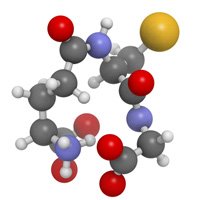Glutathione
Glutathione (GSH) is a rather special antioxidant - it is known as a super antioxidant because it neutralizes the full range of free radicals. It provides essential support for the brain, optic nerve, lens, cornea, retina/macula, and the mitochondria within cells. It also performs detoxification duties. It is made up of three amino acids: cysteine, glycine and glutamic acid and helps to move those amino acids through the cell wall. It enhances functioning of other nutrients such as vitamin C, vitamin E, alpha lipoic acid, and CoQ10

Vision Support
Supports lens health For clear unclouded vision, the lens needs a lot of glutathione and vitamin C. Both nutrients are deficient in people with cataracts.1 Glutathione also helps sugar and protein molecules from binding together. This process known as glycation occurs as a result of aging and contributes to cataract development.
Supports retinal health GSH also helps protect retinal cells from damage. Patients with macular degeneration (AMD) have 58% less glutathione than healthy patients.2 It protects pigmented cells (the internal sunglasses) from oxidative damage by a particular type of fat (a 4-hydroxynonenal type). Taken in early stages of AMD, glutathione protects the retina from neovascularization, the development of extra blood vessels.3
Detoxification Glutathione contains sulphur which sticks to free radicals and heavy metals.4 This body chemical has sulfur, which sticks to free radicals and heavy metals in the body. This capacity is helpful in protecting the gut, kidneys, lungs, and possibly diabetes. In other words, it helps 'take out the trash.'5
Supports brain health Although glutathione is found throughout the body it is most concentrated in the brain. The brains of patients with neurodegenerative conditions, such as Parkinson's6 and Alzheimer's disease7 are deficient in glutathione. Researchers have found that when GSH is depleted in the hippocampus regions of an elderly person they suffer mild cognitive impairment present in the earlier stages of AD.8 On the other hand, elderly people with high levels of glutathione have better physical health overall.9
Glutathione in Our Bodies
Glutathione can be created by the liver if it also has ample supplies of selenium, vitamin C, n-acetyl-cysteine, glycine and glutamine. But as we age we begin to be low on GSH. Alpha lipoic acid, milk thistle extract and turmeric also boost its production in the body. We can also increase our glutathione levels with exercise.10
But poor diet, toxins, pollution, stress, aging, certain medications, infections, trauma, and radiation all reduce glutathione levels. Thus our cells are more vulnerable to damage from oxidization, infections, free radicals, and even cancer. Lack of glutathione can overload the liver, hampering its ability to detoxify the body. Excessive alcohol will reduce glutathione levels.
Good food sources include: sulfur rich foods such as cruciferous vegetable (broccoli, cauliflower, brussels sprouts, kale, watercress, mustard greens), garlic, onions, shallots, avocado, spinach, okra, whey.
Glutathione is best taken sublingually intraorally as it is not well absorbed through capsules or tablets. Glutathione is not absorbed well taken in capsule or tablet form. Sublingual dosages will typically be lower because they are absorbed 5-10 times more efficiently than capsules or tablets.
Best glutathione supplement
The glutathione product that we recommend is ACG Glutathione Spray. This oral spray delivers glutathione with the best possible absorption.
We include ACG Glutathione Oral Spray in a number of discount vision support packages:
For the optic nerve: Optic Nerve Support Package B.
For the lens: Can-C Eyedrops plus ACG Glutathione Package 1G, Advanced Lens Support Package 1 (3 mo supply.
For the cornea: Corneal Support Package 2
Footnotes
1. Umapathy A, Donaldson P, Lim J. (2013). Antioxidant Delivery Pathways in the Anterior Eye. Biomed Res Int. 2013:207250.
2. Sternberg P. (1988). Treating Age-Related Macular Degeneration. Science Writers Seminar in Ophthalmology: Research to Prevent Blindness.
3. Ayalaxomayajula SP, Kompella UB. (2002). Induction of vascular endothelial growth factor by 4-hydroxynonenal and its prevention by glutathione precursors in retinal pigment epithelial cells. Euro J Pharm. Aug.
4. Lee S, Olsen T, Vinknes KJ, Refsum H, Gulseth HL, et al. (2019). Plasma Sulphur-Containing Amino Acids Physical Exercise and Insulin Sensitivity in Overweight Dysglycemic and Normal Weight Normoglycemic Men. Nutrients. Jan;11(1):10.
5. Pizzomo J. (2014). Glutathione! Integr Med (Encinitas). Feb;13(1):8-12.
6. Hauser DN, Hastings TG. (2013). Mitochondrial dysfunction and oxidative stress in Parkinson’s disease and monogenic parkinsonism.
Neurobiol Dis Mar;51:35-42.
7. Shukla D, Mandal PK, Ersland L, Gruner ER, Tripathi M, et al. (2018). Multi-Center Study on Human Brain
Glutathione Conformation using Magnetic Resonance Spectroscopy. J Alzheimers Dis. 2018;66(2):517-532.
8. Ibid. Shukla (2018).
9. Lang JM, Gleiberman L, Harburg E, DiFranceisco W, Schork A. (1994). Glutathione and morbidity in a community-based sample of
elderly. J Clin Epidemiol. 1994;47(9):1021–1026.
10. Ibid. Lee. (2019).
Glutathione News
Want to learn more? See our blog for news on glutathione.
 info@naturaleyecare.com
info@naturaleyecare.com



 Home
Home



 Vision
Vision Vision
Vision



 Health
Health Health
Health Research/Services
Research/Services Pets
Pets About/Contact
About/Contact


